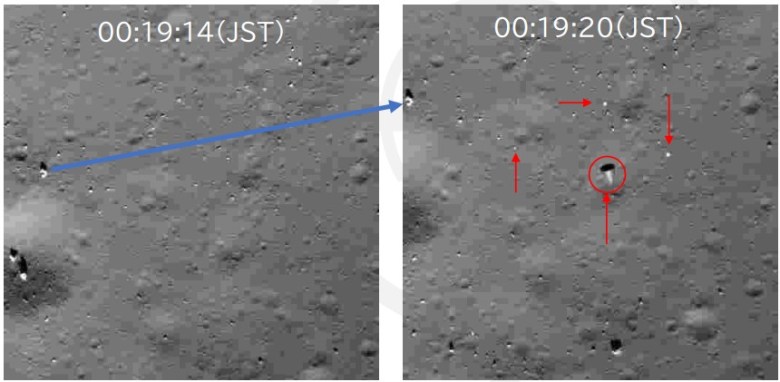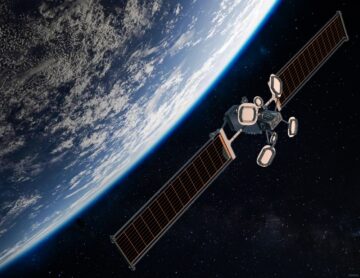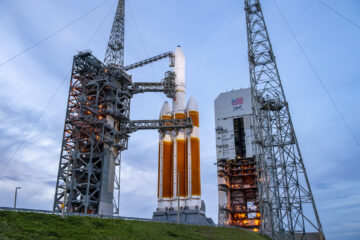HELSINKI — Japan’s SLIM moon lander has resumed operations more than a week after its imperfect yet historic lunar landing.
The Japan Aerospace Exploration Agency (JAXA) confirmed contact had been reestablished with the Smart Lander for Investigating Moon (SLIM) spacecraft late Jan. 28. The development comes just days ahead of a likely mission-ending sunset.
The large SUV-sized spacecraft was forced to power down just two over hours after landing Jan. 19 due to its solar cell not generating electricity. SLIM finally powered up again as the position of the sun in the sky changed, finally illuminated SLIM’s solar cell.
The spacecraft suffered a malfunction during descent that resulted in an unintended attitude upon landing and solar panels facing away from the sun.
JAXA stated via X, formerly known as Twitter, that science observations were immediately started with SLIM’s multiband spectroscopic camera (MBC), adding 10-band observations were made. The agency imaged a feature of a rock dubbed “toy poodle” observed by the multi-band observation.
The first hints that SLIM had been revived came from Germany-based amateur radio satellite organization AMSAT-DL. Its Bochum observatory detected a signal later confirmed to be SLIM engaged in a downlink with ground stations.
The sun will set over Shioli crater early Eastern Jan. 31, meaning SLIM has limited time to charge its batteries and conduct science observations.
Neither SLIM nor its rovers carry radioisotope heater units. Thus they are not expected to survive the lunar nighttime, when temperatures will drop to around minus 130 Celsius.
MBC aboard SLIM will attempt to make observations that could generate useful lunar science data. Katherine Joy, a Reader in Earth Sciences at the University of Manchester, told SpaceNews ahead of the landing that the target site is located on an ejecta blanket of a much larger, roughly 100 km diameter, impact crater called Theophilus.
“It might sample rocks and minerals that were excavated from deeper horizons within the lunar crust,” Joy said.
SLIM, nicknamed “Moon Sniper” for its main objective of demonstrating a precise lunar landing, touched down on the slope of the small, mid-latitude Shioli crater Jan. 19.
While it landed within 55 meters of its target point—well within the goal of 100-meter accuracy—the spacecraft suffered a malfunction with one of its two main landing engines. This led to unexpected lateral momentum and a landing which saw the spacecraft come to rest on its nose.
JAXA later published an image captured by descent cameras showing a thruster nozzle that had fallen free of the spacecraft. JAXA estimated that thrust was lost at around 50 meters above the lunar surface. There were no signs of any abnormality in the main engine until just before the incident occurred.

SLIM was intended to descend thrusters down. A smaller thruster was then to be fired to orient the spacecraft onto its side just ahead of touchdown. The spacecraft was to be cushioned by five crushable, 3D-printed aluminum lattice landing legs.
JAXA later confirmed the landing attitude meant SLIM’s solar cell is facing westwards, resulting in it initially not receiving sunlight. The agency stated that it would attempt to reestablish contact later in the roughly 14.5-Earth-day-long lunar daytime, once the arrays should be receiving sunlight.
SLIM also carried a pair of small, innovative rovers which it successfully deployed onto the moon in the final stages of descent. The 2.1-kilogram Lunar Excursion Vehicle 1 (LEV-1) uses a hopping mechanism, while LEV-2 is a 0.25-kg, baseball-sized, spherical rover.
LEV-1 transmitted to Earth an image of SLIM taken by LEV-2, demonstrating inter-robot radio wave data transmission and revealing the landing state of the main spacecraft.
- SEO Powered Content & PR Distribution. Get Amplified Today.
- PlatoData.Network Vertical Generative Ai. Empower Yourself. Access Here.
- PlatoAiStream. Web3 Intelligence. Knowledge Amplified. Access Here.
- PlatoESG. Carbon, CleanTech, Energy, Environment, Solar, Waste Management. Access Here.
- PlatoHealth. Biotech and Clinical Trials Intelligence. Access Here.
- Source: https://spacenews.com/slim-moon-lander-revived-after-solar-power-setback/
- :has
- :is
- :not
- $UP
- 1
- 100
- 13
- 130
- 14
- 19
- 20
- 28
- 29
- 31
- 32
- 50
- a
- abnormality
- above
- adding
- Aerospace
- After
- again
- agency
- ahead
- also
- amateur
- an
- and
- any
- ARE
- around
- AS
- At
- attempt
- attitude
- away
- back
- batteries
- BE
- beacon
- been
- before
- by
- called
- came
- camera
- cameras
- captured
- carried
- carry
- cell
- Celsius
- changed
- charge
- come
- comes
- Conduct
- CONFIRMED
- contact
- could
- credit
- cushioned
- data
- Days
- deeper
- demonstrating
- deployed
- descend
- detected
- Development
- down
- Drop
- dubbed
- due
- during
- Early
- earth
- Earth sciences
- eastern
- electricity
- engaged
- Engine
- Engines
- established
- estimated
- Ether (ETH)
- expected
- exploration
- facing
- Fallen
- Falling
- Feature
- Figure
- final
- final stages
- Finally
- fired
- First
- five
- For
- forced
- formerly
- Free
- from
- generate
- generating
- goal
- Ground
- had
- Have
- hints
- historic
- Horizons
- HOURS
- HTTPS
- image
- immediately
- Impact
- in
- incident
- initially
- innovative
- intended
- investigating
- IT
- ITS
- Jan
- Japan
- Japan’s
- joy
- jpg
- just
- known
- landing
- large
- larger
- Last
- Late
- later
- Led
- legs
- light
- likely
- Limited
- located
- lost
- Lunar
- made
- Main
- make
- manchester
- max-width
- MBC
- meaning
- meant
- mechanism
- might
- minerals
- minutes
- moment
- Momentum
- Moon
- more
- much
- night
- no
- nor
- nose
- objective
- observation
- observations
- observatory
- observe
- observed
- obtained
- occurred
- of
- off
- on
- once
- ONE
- onto
- Operations
- organization
- our
- over
- pair
- panels
- plato
- Plato Data Intelligence
- PlatoData
- position
- power
- powered
- precise
- published
- Radio
- Reader
- receiving
- Red
- REST
- resulted
- resulting
- revealing
- right
- Rock
- roughly
- rover
- s
- Said
- satellite
- saw
- Science
- SCIENCES
- Second
- set
- several
- should
- showing
- Shows
- side
- Signal
- Signs
- site
- sky
- Slope
- small
- smaller
- smart
- So
- solar
- solar panels
- Solar Power
- spacecraft
- stages
- started
- State
- stated
- Stations
- Successfully
- suffered
- Sun
- sunlight
- Sunset
- Surface
- survive
- switched
- taken
- Target
- than
- that
- The
- then
- There.
- they
- this
- thrust
- Thus
- time
- to
- told
- true
- Turned
- two
- Unexpected
- units
- university
- until
- upon
- useful
- uses
- UTC
- vehicle
- via
- visible
- was
- Wave
- we
- week
- were
- when
- which
- while
- will
- with
- within
- would
- X
- yet
- zephyrnet








